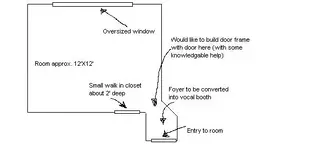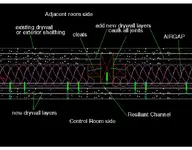Hello groovedaddy.
My thoughts: adding more layers to the existing sheetrock. Will this help or not?
It works like this. PERFECT scenario...doubling existing mass(adding 1 layer) results in 6db more transmission loss. However, it is NOT a perfect world. And, as usual with isolation, it is ONLY as good as the weakest link. In otherwords, unless ALL assemblies, which means doors, seals ceiling and floor MATCH, which ever is the least effective will be the weak link.
Considering the dimensions of the room, here is what I suggest, although it is much more work, but you get what you put in to it. To get the MOST bang for the buck WITHOUT building double walls, is to DECOUPLE a NEW INTERIOR LEAF as well as beefing up all the outer leafs from WITHIN THIS ROOM . This can only be accomplished by REMOVING the existing drywall from the walls and ceiling in this space. Resiliant Channel is the decoupling device but can NOT be attatched over existing drywall. This existing layer MUST BE REMOVED. Once the RC is installed, TWO layers of 5/8" drywall is installed on the RC. However, there are TONS things to do prior to the RC, and TONS of details to this solution, and should ONLY be undertaken after serious study of EACH DETAIL. If this sounds like something you would be interested in doing, just give me a holla and I'll layout the details for you so you can see WHAT and HOW each detail is done. This is no simple undertaking either. Paying attention to construction details are the key to a successful isolation project.
The next problem is your sound lock. The main problem using this as a booth , is it leaves NO exit or entrance to the control room while recording is in progress. We'll have to think about that one.
The next is VENTILATION or HVAC. What do you have? Please tell me EVERYTHING about this. It has a very important bearing on sound FLANKING through the ducts from other rooms if you have common ducting. So tell me all the details. In fact, if I were you, I'd climb up in the attic and LOOK at the ducting(IF EXISTS) to determine where and how to change this if possible, or if need be.
The next would be TREATMENT. Since your room is almost square as well as small, you need SERIOUS BASS ABSORPTION. More about that later.
Ok, for now, thats all I will say, although IF you are interested in this solution, you need to give me an ACCURATE drawing of the plan. I mean within 1/4" tolerance, especially to the INSIDE face of door jambs, windows, HVAC grills on the ceiling or whatever else exists in the room. Well, I'm out of time. Here is a plan view of what the RC and OUTER LEAF buildup looks like.
Oh, btw, tell me which walls are exterior, and which are adjacent to other rooms, and what is on the other side of the wall, like closets, bathrooms etc.
BTW, before this gets deeper, here is my disclaimer. I'm no expert. But there are people here who ARE, and who usually point out any incorrect information I may inadvertantly pass on. But since you asked, I'm trying to help you.
Later.
fitZ
ps. here is a TYPICAL plan section at a wall showing what I am talking about.
There is MUCH MORE to this though. Later.


